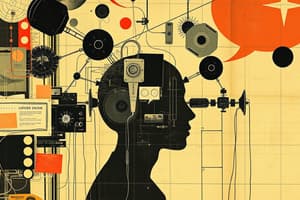Podcast
Questions and Answers
What is the primary purpose of adding redundancy in binary data transmission?
What is the primary purpose of adding redundancy in binary data transmission?
- To improve the modulation technique
- To decrease the overall data size
- To enhance the speed of transmission
- To help detect and correct errors (correct)
What aspect of a communication channel is primarily improved by modulation?
What aspect of a communication channel is primarily improved by modulation?
- The efficiency of signal transmission (correct)
- The signal-to-noise ratio
- The frequency response
- The range of transmission
Which type of communication system is best suited for undersea communication?
Which type of communication system is best suited for undersea communication?
- Wireless systems
- Radio frequency systems
- Optical fiber cables (correct)
- Satellite communication
What is considered a major problem faced by communication systems due to environmental factors?
What is considered a major problem faced by communication systems due to environmental factors?
What distinguishes data from a signal in a communication system?
What distinguishes data from a signal in a communication system?
What type of interference is aimed at impacting the quality of the transmitted signal?
What type of interference is aimed at impacting the quality of the transmitted signal?
Which of the following factors does NOT influence the need for different communication systems?
Which of the following factors does NOT influence the need for different communication systems?
What type of interference can result from poor design of communication systems?
What type of interference can result from poor design of communication systems?
What is the correct pairing of analog data with its corresponding signal type?
What is the correct pairing of analog data with its corresponding signal type?
Which of the following correctly describes a discrete signal?
Which of the following correctly describes a discrete signal?
Which wave type is primarily used to represent analog signals in communication systems?
Which wave type is primarily used to represent analog signals in communication systems?
What characteristic of a sine wave is defined as the maximum displacement from its central position?
What characteristic of a sine wave is defined as the maximum displacement from its central position?
Which of the following represents a system that utilizes Digital Data, Digital Signal?
Which of the following represents a system that utilizes Digital Data, Digital Signal?
In terms of frequency, what does a higher frequency indicate about a sine wave?
In terms of frequency, what does a higher frequency indicate about a sine wave?
What type of signal is represented by rectangular steps and is used in digital systems?
What type of signal is represented by rectangular steps and is used in digital systems?
Which combination describes Digital Data with an Analog Signal?
Which combination describes Digital Data with an Analog Signal?
What are the essential components of a communication system?
What are the essential components of a communication system?
What role does a transmitter play in a communication system?
What role does a transmitter play in a communication system?
Which aspect is NOT a function of the source encoder?
Which aspect is NOT a function of the source encoder?
The source in a communication system can be?
The source in a communication system can be?
What does channel encoding primarily aim to achieve?
What does channel encoding primarily aim to achieve?
What is the primary purpose of a transducer within a communication system?
What is the primary purpose of a transducer within a communication system?
Which process does a source encoder NOT typically involve?
Which process does a source encoder NOT typically involve?
What is the key focus when a source encoder maps a signal?
What is the key focus when a source encoder maps a signal?
Flashcards
Communication System
Communication System
The process of exchanging information from a source to a destination, including sending, receiving, and processing information or signals.
Communication System Components
Communication System Components
Any communication system has three basic parts: Transmitter, Receiver, and Communication Channel.
Transmitter
Transmitter
Prepares data for transmission over a communication channel.
Receiver
Receiver
Signup and view all the flashcards
Communication Channel
Communication Channel
Signup and view all the flashcards
Information Source
Information Source
Signup and view all the flashcards
Source Encoder
Source Encoder
Signup and view all the flashcards
Source Decoder
Source Decoder
Signup and view all the flashcards
Channel Encoder
Channel Encoder
Signup and view all the flashcards
Channel Decoder
Channel Decoder
Signup and view all the flashcards
Analog Data
Analog Data
Signup and view all the flashcards
Analog Signal
Analog Signal
Signup and view all the flashcards
Digital Data
Digital Data
Signup and view all the flashcards
Digital Signal
Digital Signal
Signup and view all the flashcards
Continuous Signal
Continuous Signal
Signup and view all the flashcards
Discrete Signal
Discrete Signal
Signup and view all the flashcards
Sine Wave
Sine Wave
Signup and view all the flashcards
Square Wave
Square Wave
Signup and view all the flashcards
Amplitude (A)
Amplitude (A)
Signup and view all the flashcards
Frequency (f)
Frequency (f)
Signup and view all the flashcards
Channel Encoder
Channel Encoder
Signup and view all the flashcards
Error Detection and Correction
Error Detection and Correction
Signup and view all the flashcards
Modulator
Modulator
Signup and view all the flashcards
Modulation
Modulation
Signup and view all the flashcards
Guided Communication Channels
Guided Communication Channels
Signup and view all the flashcards
Unguided Communication Channels
Unguided Communication Channels
Signup and view all the flashcards
Communication Channel
Communication Channel
Signup and view all the flashcards
Data (Information)
Data (Information)
Signup and view all the flashcards
Signal
Signal
Signup and view all the flashcards
Noise
Noise
Signup and view all the flashcards
Interference
Interference
Signup and view all the flashcards
Jamming
Jamming
Signup and view all the flashcards
Study Notes
Course Information
- Course Title: Information Technology
- Course Number: IT438
- Course Instructor: Kamal Hamza, PhD
- Semester: Fall 2024-2025
- Acknowledgement: Presentation includes data from "Data Communications and Networks" by W. Stallings.
Introduction
- Communication: The process of exchanging information from a source to a destination.
- Communication also refers to the process of sending, receiving, and processing information/signals between points.
Communication Systems Components
- Components of any communication system: Transmitter, Receiver, and Communication Channel.
- The transmitter formats data to be sent via the channel.
- Components of a communication system: Source encoder, Channel encoder, Modulator, Transmitter, Channel, Demodulator, Receiver, Source decoder, Channel decoder.
Communication System Components (cont.)
- Information Source: Generates messages. These can be voice, images, or keyboard input. Transducer converts non-electrical messages to electrical signals.
- Format: Analog or digital.
Source Encoder/Decoder
- Source encoder converts signals into a digital form, reducing redundancy and using the fewest bits possible.
- The encoding method needs an inverse operation (source decoding) to allow reconstruction.
- Example: Converting analog voice to digital MP3 audio.
Channel Encoder/Decoder
- Channel encoding maps signals to reduce noise.
- Adding redundancy (extra bits) for error detection and correction during transmission over noisy channels.
Examples of Guided Communication Channels
- Twisted pair: Separately insulated wires twisted together, often bundled into cables, used in building installations.
- Coaxial cable: Inner conductor surrounded by insulating material and an outer conductor to shield it from interference, used in specialized applications.
- Optical fiber: Glass or plastic core, carrying light pulses, allowing for high-bandwidth transmission.
Examples of Unguided Communication Channels
- Microwaves, Satellites, Radio Waves, Infrared
Why Different Types of Communication Systems?
- Factors influencing communication system choices:
- Channel nature (e.g., undersea cables require fiber optics)
- Application needs (e.g., wireless systems for mobile apps)
- Required quality levels (signal performance and accuracy)
- Cost considerations
Problems Facing Communication Systems
- Problems in communication systems:
- Noise: Undesired effects from the environment, typically outside of user control.
- Interference: Result of signal superposition from multiple sources.
- Jamming: Intentional interference aims to disrupt signal quality.
Problems that Face Communication Systems (cont.)
- Examples of signal degradation: distortion, signal degradation with distance, and signal loss.
Data vs. Signal
- Data represents the information to be transmitted.
- Signals are the physical representation of data within the communication system.
- Example: Voice is the information transmitted; electricity is the signal.
Types of Data and Signals
- Four combinations of data and signal types:
- Analog data/analog signal (traditional phone)
- Analog data/digital signal (VoIP, digital audio)
- Digital data/analog signal (modems, some optics)
- Digital data/digital signal (Ethernet, WIFI)
Signal Representation in the Time Domain
- Signals can be continuous (smooth intensity changes) or discrete (constant intensity levels over time).
- Common signal types in time domain: sine waves, square waves.
- Key features of signals: Amplitude, Frequency, Period, and Phase.
- Frequency = 1/Period
- Higher frequency, shorter period
- Frequency = 1/Period
- Sine wave equation: s(t) = A sin(2πft + φ); where A=Amplitude and φ=phase.
Studying That Suits You
Use AI to generate personalized quizzes and flashcards to suit your learning preferences.




